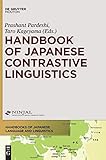Handbook of Japanese Contrastive Linguistics / ed. by Prashant Pardeshi, Taro Kageyama.
Material type: TextSeries: Handbooks of Japanese Language and Linguistics [HJLL] ; 6Publisher: Berlin ; Boston : De Gruyter Mouton, [2018]Copyright date: ©2018Description: 1 online resource (XLV, 722 p.)Content type:
TextSeries: Handbooks of Japanese Language and Linguistics [HJLL] ; 6Publisher: Berlin ; Boston : De Gruyter Mouton, [2018]Copyright date: ©2018Description: 1 online resource (XLV, 722 p.)Content type: - 9781614515692
- 9781501501210
- 9781614514077
- 495.6
- PL529 .H33 2018
- online - DeGruyter
- Issued also in print.
| Item type | Current library | Call number | URL | Status | Notes | Barcode | |
|---|---|---|---|---|---|---|---|
 eBook
eBook
|
Biblioteca "Angelicum" Pont. Univ. S.Tommaso d'Aquino Nuvola online | online - DeGruyter (Browse shelf(Opens below)) | Online access | Not for loan (Accesso limitato) | Accesso per gli utenti autorizzati / Access for authorized users | (dgr)9781614514077 |
Frontmatter -- Preface -- Introduction to the Handbooks of Japanese Language and Linguistics -- Contributors -- Introduction -- I. Verbal constructions and related issues -- 1. Transitivity in Japanese from a typological perspective -- 2. Non-canonical constructions in Japanese: A crosslinguistic perspective -- 3. Voice extension in passives and causatives -- 4. Causative constructions in Japanese and Korean -- 5. Entailed and intended results in Japanese and Burmese accomplishment verbs -- 6. Resultative constructions in Japanese from a typological perspective -- 7. Verb–Verb compounding in Japanese and Turkish -- 8. Ainu complex predicates with reference to Japanese -- 9. Motion event descriptions in Japanese from typological perspectives -- 10. Deictic motion constructions in Japanese and Thai -- 11. Event integration patterns in Sidaama and Japanese -- II. Nominal constructions and related issues -- 12. Nominalization in crosslinguistic perspective -- 13. Clausal noun-modifying constructions -- 14. Noun-modifying constructions in Swahili and Japanese -- 15. Quantifier float in Japanese and English -- 16. Measure nouns and numerals -- 17. Japanese spatial deixis in crosslinguistic perspective -- 18. ‘Who’, ‘what’, and ‘which’ in Japanese and Chinese -- 19. Inalienable possession in Japanese, English, and Warrongo -- III. Aspect, modality, and prediction -- 20. Continuous aspects in Japanese, Newar and Meche -- 21. Modality in Japanese from a crosslinguistic perspective -- 22. Modality in Japanese and Spanish -- 23. Internal state predicates in Japanese and Thai -- 24. Property predication in Koryak viewed from Japanese -- 25. Subordination and insubordination in Japanese from a crosslinguistic perspective -- Subject index
restricted access online access with authorization star
http://purl.org/coar/access_right/c_16ec
The Handbook of Japanese Contrastive Linguistics is a unique publication that brings together insights from three traditions—Japanese linguistics, linguistic typology and contrastive linguistics—and makes important contributions to deepening our understanding of various phenomena in Japanese as well other languages of the globe. Its primary goal is to uncover principled similarities and differences between Japanese and other languages of the globe and thereby shed new light on the universal as well as language-particular properties of Japanese. The issues addressed by the papers in this volume cover a wide spectrum of phenomena ranging from lexical to syntactic and discourse levels. The authors of the chapters, leading scholars in their respective field of research, present the state-of-the-art research from their respected field.
Issued also in print.
Mode of access: Internet via World Wide Web.
In English.
Description based on online resource; title from PDF title page (publisher's Web site, viewed 25. Jun 2024)


